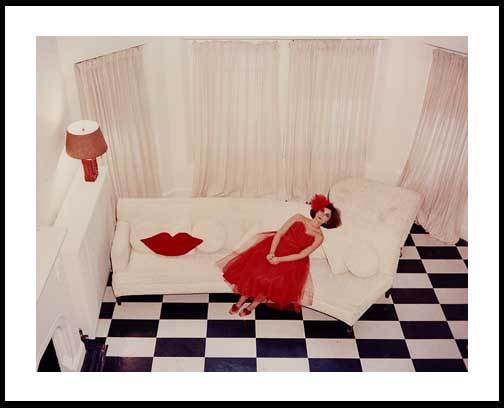 |
| Bobo in furs, October, 1974, San Francisco, from the show "Shameless" |
In my 20's, I had a vision of myself becoming an Artist with a capital A. In this vision, I saw myself exhibiting my photographs at galleries around the globe, getting glowing reviews in the major art media, and achieving fame and success. It’s a fairly common dream for those who are young and ambitious, and who aspire to make their lives momentous.
Then one day in 1978, I had a big exhibit of my work. I got a negative review in a major art journal. In her review, the critic wrote very little about my photography itself. She had nothing to say about the composition of the photographs, or their lighting or tonal range. Instead, she focused on the people in the photographs. She characterized the subjects of my photographs as inhuman, lisping, exaggerated, stereotyped posers.
I was so incensed by the review that I wrote an essay and sent it to the editor of the art journal. In the essay, I questioned the purpose of critics lambasting artists. I wrote about how much courage it takes to create something and how unhelpful it is to the world of creativity in general to have critics lambaste anyone.
The art journal published my essay. It triggered the largest number of letters to the editor in the art journal's history. There were strong opinions on both sides. There were supportive letters from famous artists, and there were letters from a raft of art critics, who wrote personal defenses of their trade, and laid on additional criticisms of me to boot. There were also letters from ordinary people—some encouraging me, others not. One letter writer called me a “nasty bitch,” “ego-posing,” “sinister,” “decadent,” and a “sickie.” He referred to my work as “photographic garbage.” Ironically, the essay I wrote was nominated for an award for best art criticism of the year. My photographs, however, won no award, and that was my real disappointment.
 |
| Tanye at his breakfast table, August, 1974, San Francisco, from the show "Shameless" |
Over the years, I’ve worked up the nerve to continue to take risks. I’ve grown more accustomed to reaping both positive and negative consequences. Experience has shown me that when I put my work out, I have to be prepared for all kinds of things. Even if I get praise, I am likely to get some condemnation as well. Some of the condemnation has been about the work I’ve created, but I’ve also received reprimands directed at me myself—as if I were loathsome for having been provocative, or for having tried something and failed at it.
The truth is, each person who takes a creative leap and puts his or her work out, makes it easier for others to follow.
I was young when I wrote my essay questioning the role of criticism. As much as anything, I was engaging in my own kind of critical revenge. But there was one truth that I hit upon in the essay that has stuck with me: "all creativity is risk". Everyone who creates a work of art takes a risk, expresses a hope and a dream. It hardly matters what the person's level of skill is. It hardly matters if the end product is timeless. I believe that it is always beneficial to society that the risk is taken. Everyone who takes the risk and creates something, nourishes creativity for all.
Nowadays, no matter how I feel about someone’s work, I try never to lose sight of the fact that the person’s creativity rises from the same impulses that motivate my own work. The artist or writer may have a different vision than mine—but the underlying urge to create and share a vision with the world—is at root no different than my impulse to share my own imagination.
To other creators, I say, keep going, keep taking risks—even in the face of criticism. Persistence, despite being criticized or ignored, gives you the opportunity to build self-confidence. It takes practice to realize that what others say about you or your work has little to do with you. It certainly says nothing about what you may ultimately achieve in life. The people who love you will still love you. And if you can love yourself, even in the face of criticism, you will have mastered one of life’s most difficult lessons.
One of the mistakes that people who criticize make is that they assume that a given creation is either good or bad—that it either has merit or is without merit. Even worse, they project this absolute judgment out to the rest of the world, as though aesthetic judgments were a science. In fact, the world has billions of people. Those billions of people do not all share the same taste. Less obvious is that world has a huge number of sub-groups of people who share distinctive tastes.
If you put your work out, it may well be that someone will appreciate your creation, even if many others do not. You may find a large number of fans, or your admirers may be just a few people. But the wider you are able to cast your net, the more likely it is that somewhere someone will appreciate what you’ve made.

No comments:
Post a Comment